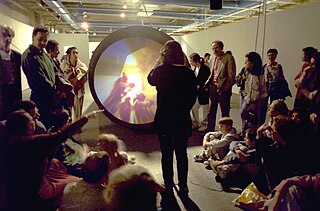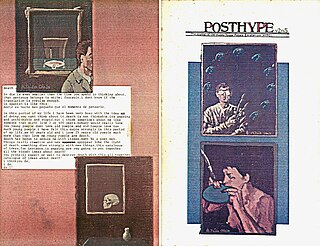
A bulletin board system (BBS), also called a computer bulletin board service (CBBS), is a computer server running software that allows users to connect to the system using a terminal program. Once logged in, the user performs functions such as uploading and downloading software and data, reading news and bulletins, and exchanging messages with other users through public message boards and sometimes via direct chatting. In the early 1980s, message networks such as FidoNet were developed to provide services such as NetMail, which is similar to internet-based email.

Email is a method of transmitting and receiving messages using electronic devices. It was conceived in the late–20th century as the digital version of, or counterpart to, mail. Email is a ubiquitous and very widely used communication medium; in current use, an email address is often treated as a basic and necessary part of many processes in business, commerce, government, education, entertainment, and other spheres of daily life in most countries.
In computer technology and telecommunications, online indicates a state of connectivity, and offline indicates a disconnected state. In modern terminology, this usually refers to an Internet connection, but could refer to any piece of equipment or functional unit that is connected to a larger system. Being online means that the equipment or subsystem is connected, or that it is ready for use.

Digital art refers to any artistic work or practice that uses digital technology as part of the creative or presentation process. It can also refer to computational art that uses and engages with digital media. Since the 1960s, various names have been used to describe digital art, including computer art, electronic art, multimedia art, and new media art.

Interactive art is a form of art that involves the spectator in a way that allows the art to achieve its purpose. Some interactive art installations achieve this by letting the observer walk through, over or around them; others ask the artist or the spectators to become part of the artwork in some way.

Mail art, also known as postal art and correspondence art, is an artistic movement centered on sending small-scale works through the postal service. It developed out of what eventually became Ray Johnson's New York Correspondence School and the Fluxus movements of the 1960s. It has since developed into a global, ongoing movement.
The computer art scene, or simply artscene, is the community interested and active in the creation of computer-based artwork.
An online service provider (OSP) can, for example, be an Internet service provider, an email provider, a news provider (press), an entertainment provider, a search engine, an e-commerce site, an online banking site, a health site, an official government site, social media, a wiki, or a Usenet newsgroup.
net.art refers to a group of artists who have worked in the medium of Internet art since 1994. Some of the early adopters and main members of this movement include Vuk Ćosić, Jodi.org, Alexei Shulgin, Olia Lialina, Heath Bunting, Daniel García Andújar, and Rachel Baker. Although this group was formed as a parody of avant garde movements by writers such as Tilman Baumgärtel, Josephine Bosma, Hans Dieter Huber and Pit Schultz, their individual works have little in common.
Internet fax, e-fax, or online fax is the use of the internet and internet protocols to send a fax (facsimile), rather than using a standard telephone connection and a fax machine. A distinguishing feature of Internet fax, compared to other Internet communications such as email, is the ability to exchange fax messages with traditional telephone-based fax machines.
Alan Sondheim is a poet, critic, musician, artist, and theorist of cyberspace from the United States.
Rhizome is an American not-for-profit arts organization that supports and provides a platform for new media art.

Internet art is a form of new media art distributed via the Internet. This form of art circumvents the traditional dominance of the physical gallery and museum system. In many cases, the viewer is drawn into some kind of interaction with the work of art. Artists working in this manner are sometimes referred to as net artists.

Vittore Baroni, is an Italian mailartist, music critic and explorer of countercultures. Since the mid-1970s he has been one of the most active and respected promoters and documenters of mail art.

John Held Jr. , is an American mailartist, author and performance artist who has been an active participant in alternative art since 1975, particularly in the fields of rubber stamp art, zine culture, and artistamps. He is one of the most prominent and respected promoters and chroniclers of mail art.

PostHype was a mail art zine founded by John P. Jacob in 1981. The first issue was created, using pressed Letraset on paper, as a birthday gift to the artist Steven Durland, and modeled on Durland's satirical mini-magazine Tacit. Each of the first four post-card sized issues of PostHype was printed using an original rubber stamp by Jacob, hand carved from photographs made using the photo-booth machine at the Times Square arcade known as Playland, which recorded the visits of other mail artists to New York City. Later issues expanded to document various mail art projects organized by Jacob.
Anna Aleksandrovna Tarshis, better known as Ry Nikonova or Rea Nikonova, was a Russian artist, poet, and writer. Many of her artworks are held in private and public collections throughout the world.
Kathy Rae Huffman is an American curator, writer, producer, researcher, lecturer and expert for video and media art. Since the early 1980s, Huffman is said to have helped establish video and new media art, online and interactive art, installation and performance art in the visual arts world. She has curated, written about, and coordinated events for numerous international art institutes, consulted and juried for festivals and alternative arts organisations. Huffman not only introduced video and digital computer art to museum exhibitions, she also pioneered tirelessly to bring television channels and video artists together, in order to show video artworks on TV. From the early 1990s until 2014, Huffman was based in Europe, and embraced early net art and interactive online environments, a curatorial practice that continues. In 1997, she co-founded the Faces mailing list and online community for women working with art, gender and technology. Till today, Huffman is working in the US, in Canada and in Europe.

Chuck Welch, also known as the CrackerJack Kid or Jack Kid, was born in Kearney, Nebraska in 1948. He wrote "Eternal Network: A Mail Art Anthology", with a foreword by Ken Friedman, which was published and edited by University of Calgary Press in 1995. The Eternal Network and the Crackerjack Kid were mentioned in a review of mail art titled "Pushing the Envelope" in 2001, and the archivist and curator Judith Hoffberg wrote about him in her publication Umbrella. His awards include a Fulbright Grant and NEA Hilda Maehling Fellowship.
Siebren Versteeg is an American artist known for his painting and video works created through digital processes. His multivalent practice responds to the technology of our time and the way we consume and deploy those technologies.









